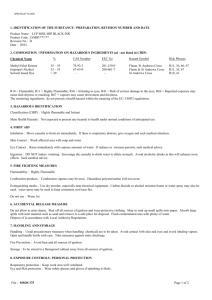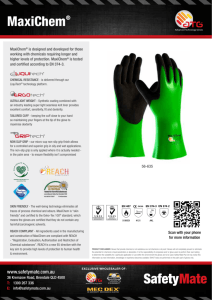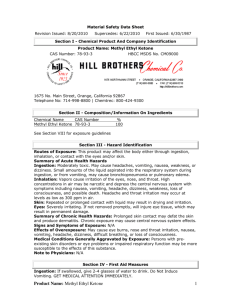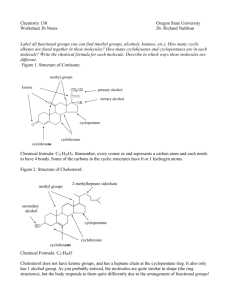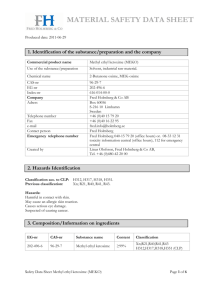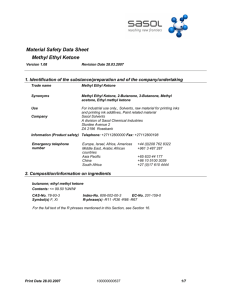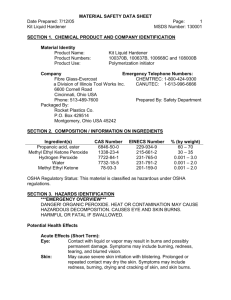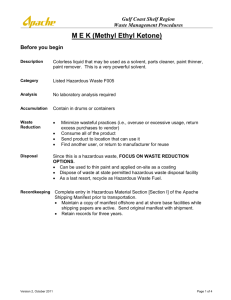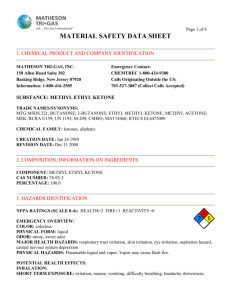Safety Data Sheet - Orica SDS Search
advertisement
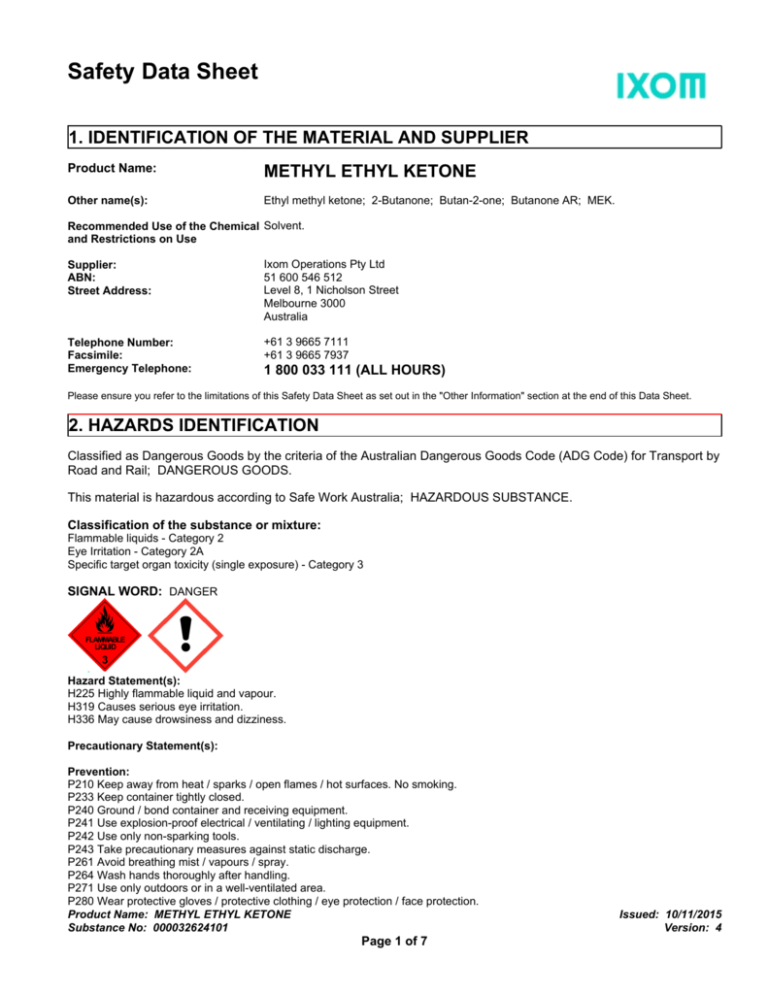
Safety Data Sheet 1. IDENTIFICATION OF THE MATERIAL AND SUPPLIER Product Name: METHYL ETHYL KETONE Other name(s): Ethyl methyl ketone; 2-Butanone; Butan-2-one; Butanone AR; MEK. Recommended Use of the Chemical Solvent. and Restrictions on Use Supplier: ABN: Street Address: Ixom Operations Pty Ltd 51 600 546 512 Level 8, 1 Nicholson Street Melbourne 3000 Australia Telephone Number: Facsimile: Emergency Telephone: +61 3 9665 7111 +61 3 9665 7937 1 800 033 111 (ALL HOURS) Please ensure you refer to the limitations of this Safety Data Sheet as set out in the "Other Information" section at the end of this Data Sheet. 2. HAZARDS IDENTIFICATION Classified as Dangerous Goods by the criteria of the Australian Dangerous Goods Code (ADG Code) for Transport by Road and Rail; DANGEROUS GOODS. This material is hazardous according to Safe Work Australia; HAZARDOUS SUBSTANCE. Classification of the substance or mixture: Flammable liquids - Category 2 Eye Irritation - Category 2A Specific target organ toxicity (single exposure) - Category 3 SIGNAL WORD: DANGER Hazard Statement(s): H225 Highly flammable liquid and vapour. H319 Causes serious eye irritation. H336 May cause drowsiness and dizziness. Precautionary Statement(s): Prevention: P210 Keep away from heat / sparks / open flames / hot surfaces. No smoking. P233 Keep container tightly closed. P240 Ground / bond container and receiving equipment. P241 Use explosion-proof electrical / ventilating / lighting equipment. P242 Use only non-sparking tools. P243 Take precautionary measures against static discharge. P261 Avoid breathing mist / vapours / spray. P264 Wash hands thoroughly after handling. P271 Use only outdoors or in a well-ventilated area. P280 Wear protective gloves / protective clothing / eye protection / face protection. Product Name: METHYL ETHYL KETONE Substance No: 000032624101 Page 1 of 7 Issued: 10/11/2015 Version: 4 Safety Data Sheet Response: P303+P361+P353 IF ON SKIN (or hair): Take off immediately all contaminated clothing. Rinse skin with water/shower. P305+P351+P338 IF IN EYES: Rinse cautiously with water for several minutes. Remove contact lenses, if present and easy to do. Continue rinsing. P337+P313 If eye irritation persists: Get medical advice/attention. P304+P340 IF INHALED: Remove person to fresh air and keep comfortable for breathing. P312 Call a POISON CENTER or doctor/physician if you feel unwell. P370+P378 In case of fire: Use extinguishing media as outlined in Section 5 of this Safety Data Sheet to extinguish. Storage: P403+P233 Store in a well-ventilated place. Keep container tightly closed. P403+P235 Store in a well-ventilated place. Keep cool. P405 Store locked up. Disposal: P501 Dispose of contents/container in accordance with local/regional/national/international regulations. Other Hazards: AUH066 Repeated exposure may cause skin dryness or cracking. Poisons Schedule (SUSMP): S5 Caution. 3. COMPOSITION AND INFORMATION ON INGREDIENTS Components Methyl ethyl ketone CAS Number 78-93-3 Proportion >99% Hazard Codes H225 H319 H336 4. FIRST AID MEASURES For advice, contact a Poisons Information Centre (e.g. phone Australia 131 126; New Zealand 0800 764 766) or a doctor. Inhalation: Remove victim from area of exposure - avoid becoming a casualty. Remove contaminated clothing and loosen remaining clothing. Allow patient to assume most comfortable position and keep warm. Keep at rest until fully recovered. If patient finds breathing difficult and develops a bluish discolouration of the skin (which suggests a lack of oxygen in the blood - cyanosis), ensure airways are clear of any obstruction and have a qualified person give oxygen through a face mask. Apply artificial respiration if patient is not breathing. Seek immediate medical advice. Skin Contact: If skin contact occurs, remove contaminated clothing and wash skin with running water. If irritation occurs seek medical advice. Eye Contact: If in eyes, hold eyelids apart and flush the eye continuously with running water. Continue flushing until advised to stop by a Poisons Information Centre or a doctor, or for at least 15 minutes. Ingestion: Rinse mouth with water. If swallowed, do NOT induce vomiting. Give a glass of water. Seek medical advice. Indication of immediate medical attention and special treatment needed: Treat symptomatically. Causes central nervous system depression. 5. FIRE FIGHTING MEASURES Product Name: METHYL ETHYL KETONE Substance No: 000032624101 Issued: 10/11/2015 Version: 4 Page 2 of 7 Safety Data Sheet Suitable Extinguishing Media: Alcohol resistant foam is the preferred firefighting medium but, if it is not available, fine water spray or water fog can be used. Unsuitable Extinguishing Media: Water jet. Hazchem or Emergency Action Code: · 2YE Specific hazards arising from the substance or mixture: Highly flammable liquid. May form flammable vapour mixtures with air. Vapour may travel a considerable distance to source of ignition and flash back. Special protective equipment and precautions for fire-fighters: All potential sources of ignition (open flames, pilot lights, furnaces, spark producing switches and electrical equipment etc) must be eliminated both in and near the work area. Do NOT smoke. Heating can cause expansion or decomposition of the material, which can lead to the containers exploding. If safe to do so, remove containers from the path of fire. Keep containers cool with water spray. On burning will emit toxic fumes, including those of oxides of carbon . Fire fighters to wear self-contained breathing apparatus and suitable protective clothing if risk of exposure to vapour or products of combustion. 6. ACCIDENTAL RELEASE MEASURES Emergency procedures/Environmental precautions: Shut off all possible sources of ignition. Clear area of all unprotected personnel. If contamination of sewers or waterways has occurred advise local emergency services. Personal precautions/Protective equipment/Methods and materials for containment and cleaning up: Slippery when spilt. Avoid accidents, clean up immediately. Wear protective equipment to prevent skin and eye contact and breathing in vapours. Work up wind or increase ventilation. Contain - prevent run off into drains and waterways. Use absorbent (soil, sand or other inert material). Collect and seal in properly labelled containers or drums for disposal. Use non-sparking tools. 7. HANDLING AND STORAGE This material is a Scheduled Poison S5 and must be stored, maintained and used in accordance with the relevant regulations. Precautions for safe handling: Avoid skin and eye contact and breathing in vapour. Keep out of reach of children. Take precautionary measures against static discharges. Do not use compressed air for filling, discharging, or handling operations. Conditions for safe storage, including any incompatibilities: Store in a cool, dry, well ventilated place. Store away from sources of heat or ignition. Store away from foodstuffs. Store away from incompatible materials described in Section 10. Keep containers closed when not in use - check regularly for leaks. 8. EXPOSURE CONTROLS/PERSONAL PROTECTION Methyl ethyl ketone (MEK): 8hr TWA = 445 mg/m3 (150 ppm), 15 min STEL = 890 mg/m3 (300 ppm) Product Name: METHYL ETHYL KETONE Substance No: 000032624101 Issued: 10/11/2015 Version: 4 Page 3 of 7 Safety Data Sheet As published by Safe Work Australia Workplace Exposure Standards for Airborne Contaminants. TWA - The time-weighted average airborne concentration of a particular substance when calculated over an eight-hour working day, for a five-day working week. STEL (Short Term Exposure Limit) - the airborne concentration of a particular substance calculated as a time-weighted average over 15 minutes, which should not be exceeded at any time during a normal eight hour work day. According to current knowledge this concentration should neither impair the health of, nor cause undue discomfort to, nearly all workers. These Workplace Exposure Standards are guides to be used in the control of occupational health hazards. All atmospheric contamination should be kept to as low a level as is workable. These workplace exposure standards should not be used as fine dividing lines between safe and dangerous concentrations of chemicals. They are not a measure of relative toxicity. Appropriate engineering controls: Ensure ventilation is adequate to maintain air concentrations below Workplace Exposure Standards. Vapour heavier than air - prevent concentration in hollows or sumps. DO NOT enter confined spaces where vapour may have collected. Keep containers closed when not in use. If in the handling and application of this material, safe exposure levels could be exceeded, the use of engineering controls such as local exhaust ventilation must be considered and the results documented. If achieving safe exposure levels does not require engineering controls, then a detailed and documented risk assessment using the relevant Personal Protective Equipment (PPE) (refer to PPE section below) as a basis must be carried out to determine the minimum PPE requirements. Individual protection measures, such as Personal Protective Equipment (PPE): The selection of PPE is dependent on a detailed risk assessment. The risk assessment should consider the work situation, the physical form of the chemical, the handling methods, and environmental factors. OVERALLS, SAFETY SHOES, CHEMICAL GOGGLES, GLOVES, RESPIRATOR. Wear overalls, chemical goggles and impervious gloves. Use with adequate ventilation. If determined by a risk assessment an inhalation risk exists, wear an organic vapour/particulate respirator or an air supplied mask meeting the requirements of AS/NZS 1715 and AS/NZS 1716. Always wash hands before smoking, eating, drinking or using the toilet. Wash contaminated clothing and other protective equipment before storage or re-use. 9. PHYSICAL AND CHEMICAL PROPERTIES Physical state: Colour: Odour: Molecular Formula: Specific Gravity: Relative Vapour Density (air=1): Vapour Pressure (20 °C): Clear Liquid Colourless Characteristic C4H8O 0.805 @20°C 2.4 @20°C 9.5 kPa Product Name: METHYL ETHYL KETONE Substance No: 000032624101 Issued: 10/11/2015 Version: 4 Page 4 of 7 Safety Data Sheet Flash Point (°C): Flammability Limits (%): Autoignition Temperature (°C): Solubility in water (g/L): Boiling Point/Range (°C): pH: Viscosity: Surface Tension: Evaporation Rate: Partition Coefficient: -4 (Abel) 1.8-11.5 515 250 @20°C 79-80.5 Not available 0.42 mPa.s @20°C (Dynamic, ASTM D-445) 24.8 mN/m @20°C 3.7 (n-Butyl acetate = 1) n-Octanol/water: log POW 0.3 10. STABILITY AND REACTIVITY Reactivity: No information available. Chemical stability: Stable under normal ambient and anticipated storage and handling conditions of temperature and pressure. Possibility of hazardous reactions: None known. Conditions to avoid: Avoid exposure to heat, sources of ignition, and open flame. Incompatible materials: Incompatible with oxidising agents , aluminium , amines , plastics , rubber , sulfuric acid , hydrochloric acid , strong alkalis . Hazardous decomposition products: Oxides of carbon. 11. TOXICOLOGICAL INFORMATION No adverse health effects expected if the product is handled in accordance with this Safety Data Sheet and the product label. Symptoms or effects that may arise if the product is mishandled and overexposure occurs are: Ingestion: Swallowing can result in nausea, vomiting and central nervous system depression. If the victim is showing signs of central system depression (like those of drunkeness) there is greater likelihood of the patient breathing in vomit and causing damage to the lungs. Aspiration hazard - this material can enter lungs during swallowing or vomiting and cause lung inflammation and damage. Eye contact: An eye irritant. Skin contact: Product Name: METHYL ETHYL KETONE Safety Data Sheet Inhalation LC50 (rat): >20 mg/L/4hrs Chronic effects: No information available for the product. 12. ECOLOGICAL INFORMATION Ecotoxicity Avoid contaminating waterways. 13. DISPOSAL CONSIDERATIONS Disposal methods: Refer to Waste Management Authority. Dispose of contents/container in accordance with local/regional/national/international regulations. 14. TRANSPORT INFORMATION Road and Rail Transport Classified as Dangerous Goods by the criteria of the Australian Dangerous Goods Code (ADG Code) for Transport by Road and Rail; DANGEROUS GOODS. UN No: Transport Hazard Class: Packing Group: Proper Shipping Name or Technical Name: Hazchem or Emergency Action Code: 1193 3 Flammable Liquid II ETHYL METHYL KETONE (METHYL ETHYL KETONE) · 2YE Marine Transport Classified as Dangerous Goods by the criteria of the International Maritime Dangerous Goods Code (IMDG Code) for transport by sea; DANGEROUS GOODS. UN No: Transport Hazard Class: Packing Group: Proper Shipping Name or Technical Name: 1193 3 Flammable Liquid II ETHYL METHYL KETONE (METHYL ETHYL KETONE) IMDG EMS Fire: IMDG EMS Spill: F-E S-D Air Transport Classified as Dangerous Goods by the criteria of the International Air Transport Association (IATA) Dangerous Goods Regulations for transport by air; DANGEROUS GOODS. UN No: Transport Hazard Class: Packing Group: Proper Shipping Name or Technical Name: 1193 3 Flammable Liquid II ETHYL METHYL KETONE (METHYL ETHYL KETONE) Product Name: METHYL ETHYL KETONE Substance No: 000032624101 Issued: 10/11/2015 Version: 4 Page 6 of 7 Safety Data Sheet 15. REGULATORY INFORMATION Classification: This material is hazardous according to Safe Work Australia; HAZARDOUS SUBSTANCE. Classification of the substance or mixture: Flammable liquids - Category 2 Eye Irritation - Category 2A Specific target organ toxicity (single exposure) - Category 3 Hazard Statement(s): H225 Highly flammable liquid and vapour. H319 Causes serious eye irritation. H336 May cause drowsiness and dizziness. Poisons Schedule (SUSMP): S5 Caution. This material is listed on the Australian Inventory of Chemical Substances (AICS). 16. OTHER INFORMATION This safety data sheet has been prepared by Ixom Operations Pty Ltd Toxicology & SDS Services. Reason(s) for Issue: 5 Yearly Revised Primary SDS This SDS summarises to our best knowledge at the date of issue, the chemical health and safety hazards of the material and general guidance on how to safely handle the material in the workplace. Since Ixom Operations Pty Ltd cannot anticipate or control the conditions under which the product may be used, each user must, prior to usage, assess and control the risks arising from its use of the material. If clarification or further information is needed, the user should contact their Ixom representative or Ixom Operations Pty Ltd at the contact details on page 1. Ixom Operations Pty Ltd's responsibility for the material as sold is subject to the terms and conditions of sale, a copy of which is available upon request. Product Name: METHYL ETHYL KETONE Substance No: 000032624101 Issued: 10/11/2015 Version: 4 Page 7 of 7
